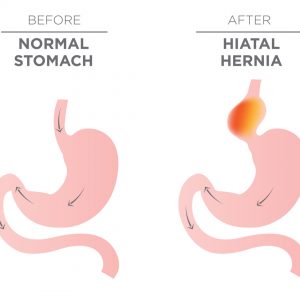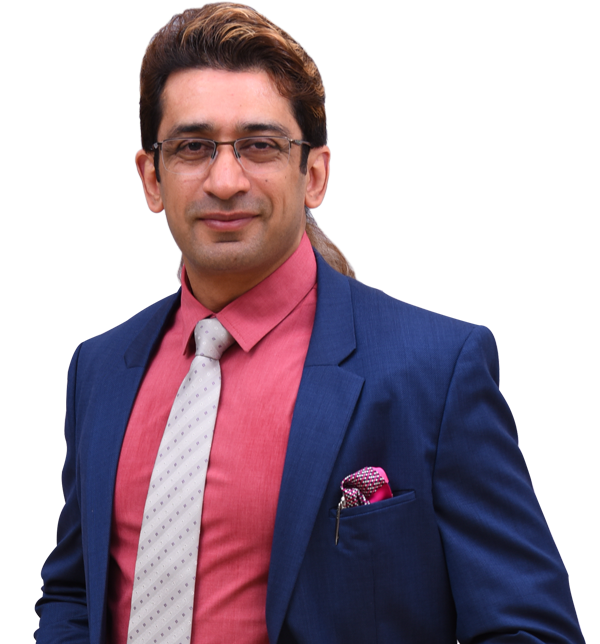
Dr. Rohit Kumar
Best Surgeon For Hernia In DubaiMD, MS, FMABS, FIASGO, FIAGES, FMAS, FHBPS, FACS
Book Now
What is Hernia?
A hernia occurs when an internal organ protrudes through the wall of muscle or tissue that normally contains it. Most hernias occur within the abdominal cavity, between the chest and the hips.
When internal fat or internal organs press through a hole in the muscle, a hernia develops. These internal organs and fat cause the skin over the hernia to ‘bulge’ out. When patients reduce the hernia back inside, often that bulge regresses and disappears. However, when the hernia contents push back through the hole in the muscle, the bulge returns. This condition does not resolve or go away on its own – therefore, a Hernia Repair is required. This is one of the most common symptoms of a hernia.
Theoretically, hernias can happen anywhere in your body, but most occur in the abdomen between the rib cage and the groin.
Types of Hernia
Hiatus Hernia

Hiatus or diaphragmatic hernias occur when a piece of your stomach protrudes through the diaphragm (the muscle that separates the chest region from the abdominal area) via the opening through which the oesophagus (food tube) passes into the stomach. Congenital diaphragmatic hernias occur in a small percentage of newborn babies and present a medical emergency. The organs that are normally found in the abdomen, push up and through the diaphragm, crowding the lungs, and may cause breathing problems.
Umbilical Hernia

Umbilical hernias are similar to inguinal hernias but are found in the area of the umbilicus (the navel or belly button area).
Inguinal Hernia

Inguinal or groin hernias occur when part of the abdominal contents (usually part of the intestine or a piece of bowel) protrudes into the groin area. Although they are often associated with older adults, inguinal hernias occur in as many as 5% of full-term babies.
Femoral Hernia

Fatty tissue or part of the intestine protrudes into the groin at the top of the inner thigh. Femoral hernias are much less common than inguinal hernias and affect mainly older women.
FAQs
What are the symptoms of a Hernia?
A hernia in the abdomen or groin can produce a noticeable lump or bulge that can be pushed back in, or that can disappear when lying down. What you may feel: a dull ache, feeling of weakness, heaviness, pressure, tingling, or a burning sensation in your abdomen, groin, or scrotum. It may get worse when you stand for long periods or strain your abdominal muscles, such as when you cough, lift heavy objects (like your children), play sports (even golf), or have a bowel movement.
More Symptoms of Hernia include:
- Swelling or bulge in the groin or scrotum
- Increased pain at the site of the bulge
- Pain while lifting
- Increase in the bulge size over time
- A dull aching sensation
- A sense of feeling full or signs of bowel obstruction
In the case of hiatal hernias there are no bulges on the outside of the body. Instead, symptoms may include heartburn, indigestion, difficulty swallowing, frequent regurgitation, and chest pain.
If you have a bulge that cannot be pushed back inside, that is red, purple, or dark, or have pain with fever, chills, and/or vomiting, go to the nearest Hospital A&E immediately. Don’t wait or hesitate, as this may indicate an emergency that can become life-threatening – seek for a hernia treatment right away.
How is Hernia Surgery done?
Hernias typically do not resolve on their own and hernia surgery may be the only way to repair them. However, Hernia Surgeon, Dr Rohit Kumar will recommend the best way to address your hernia and will tailor the best method of hernia repair that meets your needs.
One of two types of hernia surgery can be performed, depending on each patient’s case:
Laparoscopic surgery involves setting back the protruding tissue in place and stitching back the weakened muscle wall. However, instead of a cut to the outside of the abdomen or groin, tiny incisions are made to allow for the insertion of surgical tools when performing hernia surgery and repair.
Open hernia surgery, in which a cut is made into the body at the location of the hernia. The protruding tissue is set back in place and the weakened muscle wall is stitched back together. Sometimes a type of mesh is implanted in the area to provide extra support.

Specialist General Surgeon
Dr. Rohit Kumar is a reputed Specialist General Surgeon with a keen focus on Minimal Access and Bariatric Surgery. Having decades of experience in the medical field, Dr. Kumar surpasses all forms of excellence and has the drive to learn more. He’s headed surgical departments in renowned hospitals and has undertaken specialized fellowships on several topics.
Dubai,UAE